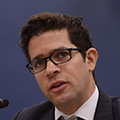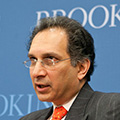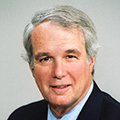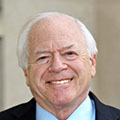 As Brookings celebrates its 100th year, our program staff and experts—past and present—reflect back on the most memorable experiences they have had as part of the Institution. As we look toward our next centenary, the Institution is proud to celebrate its rich history and showcase the many contributions our experts have made in addressing public policy challenges at the local, national, and global level.
As Brookings celebrates its 100th year, our program staff and experts—past and present—reflect back on the most memorable experiences they have had as part of the Institution. As we look toward our next centenary, the Institution is proud to celebrate its rich history and showcase the many contributions our experts have made in addressing public policy challenges at the local, national, and global level.
2016
Enlightening digital trade talks
 My paper on the importance of transatlantic data flows for trade and investment was quoted by European Commission Vice President Andrus Ansip in a speech in June this year in Washington, D.C., and the U.S. Department of Commerce has told me a number of times that this paper is the most widely quoted work in the Department and is used frequently in their negotiations with the EU over digital trade issues.
My paper on the importance of transatlantic data flows for trade and investment was quoted by European Commission Vice President Andrus Ansip in a speech in June this year in Washington, D.C., and the U.S. Department of Commerce has told me a number of times that this paper is the most widely quoted work in the Department and is used frequently in their negotiations with the EU over digital trade issues.
Reshaping global trade and investment strategies
As a result of the Global Cities Initiative, over 28 regions in the United States—representing 30 percent of the U.S. economy—have produced global trade and investment strategies focused on exports, foreign direct investment, and other drivers of global competitiveness. This work has redefined the idea of a global city, empowering a range of U.S. and international cities to strengthen core economic fundamentals and actively engage in the global economy.
2015
Informing the Supreme Court’s decision on gay marriage
 I first came to Brookings as a resident writer (and later a guest scholar) in 1996, concurrent with the start of my 19 years of writing and thinking about gay marriage. My book and many articles and talks made the social conservative, pro-family case for same-sex marriage, and Brookings was the home and incubator for that work.
I first came to Brookings as a resident writer (and later a guest scholar) in 1996, concurrent with the start of my 19 years of writing and thinking about gay marriage. My book and many articles and talks made the social conservative, pro-family case for same-sex marriage, and Brookings was the home and incubator for that work.

On June 26, 2015, the Supreme Court legalized same-sex marriage, and Justice Kennedy’s decision echoes the pro-family, communitarian arguments that I and others advanced. I’m now married in all 50 states!
Serving on the UN High-Level Panel on the Post-2015 Development Agenda
 Senior Fellow and Deputy Director Homi Kharas served as the lead author and executive secretary for the United Nations High-Level Panel on the Post-2015 Development Agenda, which was co-chaired by President Susilo Bambang Yudhoyono of Indonesia, President Ellen Johnson Sirleaf of Liberia, and Prime Minister David Cameron of the United Kingdom. The panel’s goal was to advise the U.N. secretary general on a post-2015 development agenda, following the expiration of the Millennium Development Goals in 2015. After nine months of intense negotiation and consultation, the report was published in May 2013 to widespread praise and support. Many of its recommendations and conclusions were accepted by the U.N. member states, which have just adopted a new set of Sustainable Development Goals at a Leaders’ Summit in September 2015. These goals will guide universal development from 2015 to 2030.
Senior Fellow and Deputy Director Homi Kharas served as the lead author and executive secretary for the United Nations High-Level Panel on the Post-2015 Development Agenda, which was co-chaired by President Susilo Bambang Yudhoyono of Indonesia, President Ellen Johnson Sirleaf of Liberia, and Prime Minister David Cameron of the United Kingdom. The panel’s goal was to advise the U.N. secretary general on a post-2015 development agenda, following the expiration of the Millennium Development Goals in 2015. After nine months of intense negotiation and consultation, the report was published in May 2013 to widespread praise and support. Many of its recommendations and conclusions were accepted by the U.N. member states, which have just adopted a new set of Sustainable Development Goals at a Leaders’ Summit in September 2015. These goals will guide universal development from 2015 to 2030.
Raising the profile of the Central African Republic’s “neglected crisis”
 The Central African Republic has been in crisis since a 2012 coup provoked large-scale violence along religious lines throughout the country. Brookings’s Africa Growth Initiative (AGI) has been highly influential in raising the profile of the CAR’s “neglected crisis” through a series of blog pieces, public events, and briefings with high-level Central African and U.S. government representatives. In March 2014, AGI hosted a public event with the Catholic, Protestant, and Muslim interfaith leaders of the CAR and provided them with a platform to articulate their message of interreligious acceptance and cooperation.
The Central African Republic has been in crisis since a 2012 coup provoked large-scale violence along religious lines throughout the country. Brookings’s Africa Growth Initiative (AGI) has been highly influential in raising the profile of the CAR’s “neglected crisis” through a series of blog pieces, public events, and briefings with high-level Central African and U.S. government representatives. In March 2014, AGI hosted a public event with the Catholic, Protestant, and Muslim interfaith leaders of the CAR and provided them with a platform to articulate their message of interreligious acceptance and cooperation.

Moreover, in September, Interim President Catherine Samba-Panza came to Brookings to discuss the transitional government’s work to define the national vision for the future of the Central African Republic. She spoke about domestic and international efforts to quell ongoing violence and prepare the country for national elections in 2015. Amplifying the perspectives of Central African leaders in an international public forum such as Brookings is particularly important for the CAR given its extreme dependence on international assistance and its low profile within foreign policy discussions. The discussions at Brookings helped showcase the CAR’s national agenda and peacebuilding initiatives while illustrating the gaps that exist in programming and funding, where international partners could intervene. Lessons from these events, meetings, and blogs were distilled in a Brookings report on the CAR that was released in advance of the country’s national elections in October 2015.
Contributing to the American Savings Promotion Act
 In December 2014, Congress passed the American Savings Promotion Act and President Obama signed it into law. This legislation represented the success of many years’ work by Brookings scholars Stuart Butler and Melissa Kearney to develop and analyze the idea of prize-linked savings. This idea combines elements of lotteries with more traditional savings to encourage increased savings in low-income communities by diverting the impulse to buy lottery tickets into a mechanism for building personal savings. Kearney and Butler separately contributed to the research and policy analysis needed to build the case for and helped introduce the concept to the lawmakers who sponsored the legislation that amended federal banking laws to permit these accounts to be offered by federal institutions.
In December 2014, Congress passed the American Savings Promotion Act and President Obama signed it into law. This legislation represented the success of many years’ work by Brookings scholars Stuart Butler and Melissa Kearney to develop and analyze the idea of prize-linked savings. This idea combines elements of lotteries with more traditional savings to encourage increased savings in low-income communities by diverting the impulse to buy lottery tickets into a mechanism for building personal savings. Kearney and Butler separately contributed to the research and policy analysis needed to build the case for and helped introduce the concept to the lawmakers who sponsored the legislation that amended federal banking laws to permit these accounts to be offered by federal institutions.
Amending the African Growth and Opportunity Act
On May 14, the U.S. Senate voted to reauthorize the African Growth and Opportunity Act (AGOA) and Brookings research was highly influential in the creation of the renewal legislation. In particular, in February 2015, Brookings Fellow Joshua Meltzer published a policy brief, entitled “Reforming the African Growth and Opportunity Act to grow agriculture trade”. This piece identified specific mechanisms for AGOA to be reformed in order to better enable agricultural exports under the program and specifically provide specialized outreach to women farmers. Meltzer’s piece was favorably received by many American legislators, and, on April 20, Meltzer, AGI director Amadou Sy, and associate director Andrew Westbury briefed high level staffers from the Office of Senator Debbie Stabenow (D-MI), ranking member of the Senate Agriculture Committee. Based on this discussion, Senators Stabenow and Pat Roberts (R-KS), introduced a bi-partisan amendment that strengthens trade capacity of smallholder women farmers. This amendment, in particular, increases both the number of countries eligible for this technical assistance and the number of U.S. Department of Agriculture staff persons allocated to these assignments and directs this support toward women farmers and entrepreneurs.
2013
Fostering trade and collaboration between Mexico City and Chicago
 In 2013, we brokered a novel “trade pact” between two major metropolitan areas: Mexico City and Chicago. Mayors of both cities, Miguel Ángel Mancera and Rahm Emanuel, came together to formally sign a Global Cities Economic Partnership at the Mexico City forum of the Global Cities Initiative. The Chicago entrepreneurial hub 1871 and Startup Mexico in Mexico City are now collaborating formally, giving start-ups access to co-sharing spaces and connections in both markets.
In 2013, we brokered a novel “trade pact” between two major metropolitan areas: Mexico City and Chicago. Mayors of both cities, Miguel Ángel Mancera and Rahm Emanuel, came together to formally sign a Global Cities Economic Partnership at the Mexico City forum of the Global Cities Initiative. The Chicago entrepreneurial hub 1871 and Startup Mexico in Mexico City are now collaborating formally, giving start-ups access to co-sharing spaces and connections in both markets.
— Amy Liu
Identifying the changing geography of poverty
 In the 10 years we’ve been documenting the rapid rise and growing concentration of poverty in America’s suburbs, including in our book “Confronting Suburban Poverty in America,” Alan Berube and I have helped call attention to and raise awareness of the changing geography of poverty and its implications for policy and practice. We have participated in and helped advance policy, practice, and funding discussions around these issues in dozens of metropolitan areas across the country, often helping to shine a spotlight on communities where growing poverty had been overlooked by local, regional, and national leaders. And we continue to engage with policymakers and practitioners at the local, regional, state, and federal levels on promising policy responses that more effectively respond to the modern landscape of poverty.
In the 10 years we’ve been documenting the rapid rise and growing concentration of poverty in America’s suburbs, including in our book “Confronting Suburban Poverty in America,” Alan Berube and I have helped call attention to and raise awareness of the changing geography of poverty and its implications for policy and practice. We have participated in and helped advance policy, practice, and funding discussions around these issues in dozens of metropolitan areas across the country, often helping to shine a spotlight on communities where growing poverty had been overlooked by local, regional, and national leaders. And we continue to engage with policymakers and practitioners at the local, regional, state, and federal levels on promising policy responses that more effectively respond to the modern landscape of poverty.
Propelling Colorado’s aerospace sector forward
 In 2013, my team from the Metro Program worked closely with a variety of stakeholders in the Colorado aerospace sector to help the state defend and extend the sector amid much uncertainty. The strategy report we developed—“Launch! Taking Colorado’s Space Economy to the Next Level”—led the state to create a 10 year, $150 million matching grant program in Colorado to accelerate the scale up of critical technologies by the state’s many young and small tech firms. Governor Hickenlooper also appointed an aerospace and defense “champion” to bird-dog continued growth in the ecosystem.
In 2013, my team from the Metro Program worked closely with a variety of stakeholders in the Colorado aerospace sector to help the state defend and extend the sector amid much uncertainty. The strategy report we developed—“Launch! Taking Colorado’s Space Economy to the Next Level”—led the state to create a 10 year, $150 million matching grant program in Colorado to accelerate the scale up of critical technologies by the state’s many young and small tech firms. Governor Hickenlooper also appointed an aerospace and defense “champion” to bird-dog continued growth in the ecosystem.
Presenting on education assessments in Kenya
 After we launched the Learning Metrics Task Force recommendations report in 2013, there was a lot of interest from national governments and teachers on how to adapt the recommendations to their contexts, as many of them had been involved in the formulation of the recommendations. Kenya was especially keen, and invited me and one of the Center for Universal Education’s longtime friends and consultants, Dzingai Mutumbuka, to launch the report at the Ministry of Education with their permanent secretary. While this high-level launch was important, the real impact happened when went on to Mombasa to the annual head teachers’ conference.
After we launched the Learning Metrics Task Force recommendations report in 2013, there was a lot of interest from national governments and teachers on how to adapt the recommendations to their contexts, as many of them had been involved in the formulation of the recommendations. Kenya was especially keen, and invited me and one of the Center for Universal Education’s longtime friends and consultants, Dzingai Mutumbuka, to launch the report at the Ministry of Education with their permanent secretary. While this high-level launch was important, the real impact happened when went on to Mombasa to the annual head teachers’ conference.

Over three days, we made mini-presentations in a tent to nearly 10,000 school leaders from across Kenya. Our Kenyan colleagues were the ones leading the discussions among the head teachers, which focused on how to shift the focus of education to access plus learning, and how they might do better at assessing learning. These consultations resulted in the Education Ministry developing new tools to evaluate schools based on multiple domains of quality, rather than relying on narrow examinations results.
Investigating the Tennessee auto sector
 In 2013, the Metro Program drilled down on the Tennessee auto sector, seeking to understand better how a southern state could move a classic production-oriented advanced industry “up the value chain.” Our report, “Drive! Moving Tennessee’s Automotive Sector Up the Value Chain,” was widely credited with shedding a lot of new light on the sector, and resulted in Tennessee creating a $10 million Skills Gap Grant Competition to call forth industry-aligned and highly relevant regional workforce development innovations. The study also resulted in RevV!, a business innovation voucher that has now been picked up as a pilot program within the Department of Energy and in the state of Rhode Island.
In 2013, the Metro Program drilled down on the Tennessee auto sector, seeking to understand better how a southern state could move a classic production-oriented advanced industry “up the value chain.” Our report, “Drive! Moving Tennessee’s Automotive Sector Up the Value Chain,” was widely credited with shedding a lot of new light on the sector, and resulted in Tennessee creating a $10 million Skills Gap Grant Competition to call forth industry-aligned and highly relevant regional workforce development innovations. The study also resulted in RevV!, a business innovation voucher that has now been picked up as a pilot program within the Department of Energy and in the state of Rhode Island.
2012
Bringing outlier “science” into mainstream policy
 I distinctly remember sitting in central London in December 2012 with other members of a National Academy of Sciences panel on well-being metrics and policy. We were in the U.K. to meet with the members of the British cabinet and statistics team that had just finished the first round of including well-being metrics in the British equivalent of the census and with the team charged with including the same kinds of metrics in statistics offices for all OECD countries, and to discuss how this would work in the U.S. That “moment” was followed by a special meeting at the U.N general assembly a few months later to discuss the possibility of happiness as an additional Millennium Development Goal.
I distinctly remember sitting in central London in December 2012 with other members of a National Academy of Sciences panel on well-being metrics and policy. We were in the U.K. to meet with the members of the British cabinet and statistics team that had just finished the first round of including well-being metrics in the British equivalent of the census and with the team charged with including the same kinds of metrics in statistics offices for all OECD countries, and to discuss how this would work in the U.S. That “moment” was followed by a special meeting at the U.N general assembly a few months later to discuss the possibility of happiness as an additional Millennium Development Goal.

This outlier “science” of measuring happiness and well-being – in which I was one of the original participants, including hosting meetings at Brookings – had clearly gone from the far edges of economics to the mainstream of policy. The momentum since then has been amazing, both in the social sciences and in the policy world, as governments, cities, and communities around the world (including in the U.S.) have begun to use these metrics to complement traditional income based metrics to design policies and to assess outcomes.
Revealing hidden burdens on the middle class in Romney’s tax plans
 In 2012, Adam Looney, Sam Brown, and I wrote “On The Distributional Effects of Base-Broadening Income Tax Reform.” The paper examines the tradeoffs among three competing goals that are inherent in a revenue-neutral income tax reform—maintaining tax revenues, ensuring a progressive tax system, and lowering marginal tax rates—drawing on the example of the tax policies advanced in Mitt Romney’s tax plans as a 2012 presidential candidate. We found that if Governor Romney followed through on his stated plans for tax changes, he would have to raise taxes on the middle class to finance the cuts. This created a firestorm, and the paper received enormous media attention. President Obama mentioned the study in multiple campaign speeches the morning it was released. The study was also mentioned by the candidates in the presidential and vice-presidential debates.
In 2012, Adam Looney, Sam Brown, and I wrote “On The Distributional Effects of Base-Broadening Income Tax Reform.” The paper examines the tradeoffs among three competing goals that are inherent in a revenue-neutral income tax reform—maintaining tax revenues, ensuring a progressive tax system, and lowering marginal tax rates—drawing on the example of the tax policies advanced in Mitt Romney’s tax plans as a 2012 presidential candidate. We found that if Governor Romney followed through on his stated plans for tax changes, he would have to raise taxes on the middle class to finance the cuts. This created a firestorm, and the paper received enormous media attention. President Obama mentioned the study in multiple campaign speeches the morning it was released. The study was also mentioned by the candidates in the presidential and vice-presidential debates.
2011
Working toward more sustainable economic growth
 After the Great Recession, my colleagues and I collaborated with public- and private-sector leaders in 29 states and metropolitan areas to reorient economic development to support more sustainable, inclusive growth. These efforts, coordinated through the Project on State and Metropolitan Innovation, resulted in a $10-million-plus workforce intermediary in Memphis, designed to better align employer demand and regional educational offerings; a plan to revitalize Syracuse’s postindustrial economy with strategies including leveraging regional assets in R&D, defense, and information technology; and a multi-year Advanced Industries Accelerator grant program in Colorado that supports R&D, commercialization, and start-ups within key sectors.
After the Great Recession, my colleagues and I collaborated with public- and private-sector leaders in 29 states and metropolitan areas to reorient economic development to support more sustainable, inclusive growth. These efforts, coordinated through the Project on State and Metropolitan Innovation, resulted in a $10-million-plus workforce intermediary in Memphis, designed to better align employer demand and regional educational offerings; a plan to revitalize Syracuse’s postindustrial economy with strategies including leveraging regional assets in R&D, defense, and information technology; and a multi-year Advanced Industries Accelerator grant program in Colorado that supports R&D, commercialization, and start-ups within key sectors.
— Amy Liu
2009
Helping British Prime Minister Gordon Brown with G-20 planning
 On February 9, 2009, Brookings organized a day-long conference with [then-British Prime Minister] Gordon Brown’s G-20 team, opened by the prime minister himself, to scope out issues they identified to help them prepare for the second G-20 leaders-level summit. Ideas put forward, which appeared in the London G-20 Summit communique on April 2, were: trillion dollar funding for the IMF; expanded representation at and strengthening of the Financial Stability Board; and IMF and World Bank governance reforms to provide greater voice for emerging market economies.
On February 9, 2009, Brookings organized a day-long conference with [then-British Prime Minister] Gordon Brown’s G-20 team, opened by the prime minister himself, to scope out issues they identified to help them prepare for the second G-20 leaders-level summit. Ideas put forward, which appeared in the London G-20 Summit communique on April 2, were: trillion dollar funding for the IMF; expanded representation at and strengthening of the Financial Stability Board; and IMF and World Bank governance reforms to provide greater voice for emerging market economies.
Influencing the metropolitan agenda in a new administration
 In anticipation of a new federal administration, we launched the Blueprint for American Prosperity, which put forward all of our ideas for a metropolitan agenda – cross-cutting, bottom-up solutions around the key drivers of the regional economy. Most of those ideas led to key reforms in the Obama administration. Choice Neighborhoods at the Department of Housing and Urban Development, transformative TIGER grants at the Transportation Department, and the multi-agency approach to the Sustainable Communities Initiative, Regional Innovation Clusters, manufacturing innovation hubs, and energy labs all came through policy briefs we produced through the Blueprint.
In anticipation of a new federal administration, we launched the Blueprint for American Prosperity, which put forward all of our ideas for a metropolitan agenda – cross-cutting, bottom-up solutions around the key drivers of the regional economy. Most of those ideas led to key reforms in the Obama administration. Choice Neighborhoods at the Department of Housing and Urban Development, transformative TIGER grants at the Transportation Department, and the multi-agency approach to the Sustainable Communities Initiative, Regional Innovation Clusters, manufacturing innovation hubs, and energy labs all came through policy briefs we produced through the Blueprint.
— Bruce Katz and Amy Liu
2008
Contributing to financial sector reforms in India
 I served on a committee that was set up by the Indian government to develop a blueprint for financial sector reforms in India. This was in 2008, around the time I joined Brookings. The committee was headed by Raghuram Rajan, who is now the governor of India’s central bank, the Reserve Bank of India (RBI). Many of the recommendations in that report have been implemented by Mr. Rajan. In particular, a key recommendation in a chapter of the report that I drafted on macroeconomic policy, and that Mr. Rajan and I developed further in a set of op-ed pieces and other articles, was implemented by the Indian government earlier this year. This was the adoption of an inflation targeting framework, which makes the maintenance of low and stable inflation the main objective of the RBI.
I served on a committee that was set up by the Indian government to develop a blueprint for financial sector reforms in India. This was in 2008, around the time I joined Brookings. The committee was headed by Raghuram Rajan, who is now the governor of India’s central bank, the Reserve Bank of India (RBI). Many of the recommendations in that report have been implemented by Mr. Rajan. In particular, a key recommendation in a chapter of the report that I drafted on macroeconomic policy, and that Mr. Rajan and I developed further in a set of op-ed pieces and other articles, was implemented by the Indian government earlier this year. This was the adoption of an inflation targeting framework, which makes the maintenance of low and stable inflation the main objective of the RBI.
2007
Proposing a retirement plan supported by the Obama administration
 In 2007, J. Mark Iwry and David John authored a Retirement Security Project (RSP) paper proposing automatic individual retirement accounts (IRAs) for people who were not covered by a defined benefit or 401k plan at work. Specifically, under the plan, employers with more than 10 employees that had been in business for at least two years and did not sponsor any plan for their employees would allow employees to use their payroll system to channel their own money to an IRA. Additionally, employers would retain the option at all times to set up a 401k or other retirement plan instead of a payroll-deposit IRA. Enrollment would be automatic, and employees would save a proportion of their pay in an IRA unless they opted out of the program. Drawing off the RSP proposal, automatic IRAs were subsequently part of President Obama’s 2008 campaign tax plan, and he advocated for universal savings accounts in a 2009 address to a joint session of Congress. These savings plans were also highlighted in every White House budget proposal since Fiscal Year 2010.
In 2007, J. Mark Iwry and David John authored a Retirement Security Project (RSP) paper proposing automatic individual retirement accounts (IRAs) for people who were not covered by a defined benefit or 401k plan at work. Specifically, under the plan, employers with more than 10 employees that had been in business for at least two years and did not sponsor any plan for their employees would allow employees to use their payroll system to channel their own money to an IRA. Additionally, employers would retain the option at all times to set up a 401k or other retirement plan instead of a payroll-deposit IRA. Enrollment would be automatic, and employees would save a proportion of their pay in an IRA unless they opted out of the program. Drawing off the RSP proposal, automatic IRAs were subsequently part of President Obama’s 2008 campaign tax plan, and he advocated for universal savings accounts in a 2009 address to a joint session of Congress. These savings plans were also highlighted in every White House budget proposal since Fiscal Year 2010.
Coining the term “gateway cities”
 Sometimes, if you’re lucky, research strikes a chord and continues to resonate years after the fact. One report like that has been our 2007 Metro Program project, “Reconnecting Massachusetts Gateway Cities.” In that study of 11 older industrial cities, we at Metro and our partners at MassINC—a think tank that focuses on Massachusetts’ middle class—coined the term “gateway city” to refer to the ring of often-struggling mill towns that encircle Boston. The term has stuck, and so has an appetite to enlist state and local policy to renew the cities. Over the years, the Boston Globe has run a series and editorials on the subject; a gateway cities caucus has been formed in the Massachusetts legislature; MassINC continues to publish reports on the topic; and the term is now in the lexicon in Massachusetts.
Sometimes, if you’re lucky, research strikes a chord and continues to resonate years after the fact. One report like that has been our 2007 Metro Program project, “Reconnecting Massachusetts Gateway Cities.” In that study of 11 older industrial cities, we at Metro and our partners at MassINC—a think tank that focuses on Massachusetts’ middle class—coined the term “gateway city” to refer to the ring of often-struggling mill towns that encircle Boston. The term has stuck, and so has an appetite to enlist state and local policy to renew the cities. Over the years, the Boston Globe has run a series and editorials on the subject; a gateway cities caucus has been formed in the Massachusetts legislature; MassINC continues to publish reports on the topic; and the term is now in the lexicon in Massachusetts.
Developing an index on housing and transportation affordability
 At the height of the American real estate bubble in the early 2000s, many home buyers practiced a policy of “drive till you qualify” out to distant suburbs to find houses they could afford to buy or rent. However, these decisions neglected to consider the costs of transportation, the second largest expense for the average American household. To help households evaluate the true cost of location choices we worked with the Center for Neighborhood Technology to develop a new Housing + Transportation Affordability Index. Insurance companies began looking at combined costs when giving mortgages; Denver used the info to make decisions on transit spending; and the Federal Transit Administration incorporated these metrics when giving awards. (See the Brookings policy brief “The Affordability Index: A New Tool for Measuring the True Affordability of a Housing Choice”)
At the height of the American real estate bubble in the early 2000s, many home buyers practiced a policy of “drive till you qualify” out to distant suburbs to find houses they could afford to buy or rent. However, these decisions neglected to consider the costs of transportation, the second largest expense for the average American household. To help households evaluate the true cost of location choices we worked with the Center for Neighborhood Technology to develop a new Housing + Transportation Affordability Index. Insurance companies began looking at combined costs when giving mortgages; Denver used the info to make decisions on transit spending; and the Federal Transit Administration incorporated these metrics when giving awards. (See the Brookings policy brief “The Affordability Index: A New Tool for Measuring the True Affordability of a Housing Choice”)
2006
Developing a go-to resource for media and policymakers after Hurricane Katrina
 The Metro program’s Katrina/New Orleans Index was the go-to resource for media and policymakers in Washington and the New Orleans region for many years, including gaining regular space in the New York Times op-ed section for the first five years post-Katrina. Over time, the Index has served as a national model for how communities develop the data to assess progress and set goals for recovery in the wake of major catastrophes. For Brookings, the New Orleans Index had another lasting impact – the collaboration with the New Orleans Data Center helped make the emergent Data Center into a formidable force for economic, environmental, and social trends and policy in the region.
The Metro program’s Katrina/New Orleans Index was the go-to resource for media and policymakers in Washington and the New Orleans region for many years, including gaining regular space in the New York Times op-ed section for the first five years post-Katrina. Over time, the Index has served as a national model for how communities develop the data to assess progress and set goals for recovery in the wake of major catastrophes. For Brookings, the New Orleans Index had another lasting impact – the collaboration with the New Orleans Data Center helped make the emergent Data Center into a formidable force for economic, environmental, and social trends and policy in the region.
— Amy Liu
2005
Learning from Israel’s experience in counterterrorism
 Around 2005 or so Martin [Indyk] invited Avi Dichter, the former head of Israel’s domestic intelligence service, to be a visiting fellow and asked me to work with him. The experience was eye-opening. The second intifada was winding down, and Israel’s experiences seemed an eerie parallel—for worse as well as for better—of what the U.S. was experiencing. On issues like torture, targeted killing, the role of lawyers in counterterrorism, and many other issues, Israel had wrestled with problems the U.S. was just beginning to experience. The collaboration with Dichter led to several high-profile articles (op-eds in places like the WSJ and a longer piece in Foreign Affairs) on Israel’s experiences and the implications for the U.S. It also led me to research a longer book, “A High Price: The Triumphs and Failures of Israeli Counterterrorism,” on the subject. The collaboration enabled me to be ahead of many debates, writing on issues like targeted killings years before others outside government took it up. I gave many talks and private briefings.
Around 2005 or so Martin [Indyk] invited Avi Dichter, the former head of Israel’s domestic intelligence service, to be a visiting fellow and asked me to work with him. The experience was eye-opening. The second intifada was winding down, and Israel’s experiences seemed an eerie parallel—for worse as well as for better—of what the U.S. was experiencing. On issues like torture, targeted killing, the role of lawyers in counterterrorism, and many other issues, Israel had wrestled with problems the U.S. was just beginning to experience. The collaboration with Dichter led to several high-profile articles (op-eds in places like the WSJ and a longer piece in Foreign Affairs) on Israel’s experiences and the implications for the U.S. It also led me to research a longer book, “A High Price: The Triumphs and Failures of Israeli Counterterrorism,” on the subject. The collaboration enabled me to be ahead of many debates, writing on issues like targeted killings years before others outside government took it up. I gave many talks and private briefings.
Predicting the Pension Protection Act
 In 2005, J. Mark Iwry, Peter Orszag, and I authored a Retirement Security Project paper outlining “the automatic 401k.” As described in the paper, the automatic 401k features automatic enrollment with an option for the employee to self-select out of the program. This was opposite of the previous conventional practice where employees were required to opt-in to a retirement program. Contributions to the automatic 401k plan would also increase automatically over time, and they would be automatically invested in balanced, prudently diversified, and low-cost vehicles unless the employee makes other choices. In 2006, the Pension Protection Act (PPA) was enacted with much attention given to enhanced automatic retirement saving features. It also created a “safe harbor” for plans with automatic enrollment by requiring the employer to provide deferral notices and investment information, and allowing the employee to change the contribution levels. Under the PPA, employees who are automatically enrolled in a retirement contribution plan have 90 days to opt out of the program and withdraw any contributions. Additionally, the legislation requires that automatic plans choose a set of default investments.
In 2005, J. Mark Iwry, Peter Orszag, and I authored a Retirement Security Project paper outlining “the automatic 401k.” As described in the paper, the automatic 401k features automatic enrollment with an option for the employee to self-select out of the program. This was opposite of the previous conventional practice where employees were required to opt-in to a retirement program. Contributions to the automatic 401k plan would also increase automatically over time, and they would be automatically invested in balanced, prudently diversified, and low-cost vehicles unless the employee makes other choices. In 2006, the Pension Protection Act (PPA) was enacted with much attention given to enhanced automatic retirement saving features. It also created a “safe harbor” for plans with automatic enrollment by requiring the employer to provide deferral notices and investment information, and allowing the employee to change the contribution levels. Under the PPA, employees who are automatically enrolled in a retirement contribution plan have 90 days to opt out of the program and withdraw any contributions. Additionally, the legislation requires that automatic plans choose a set of default investments.
2002
Shedding light on a policy blind spot
 In the early 2000s we noticed that older, inner-ring suburbs—containing one-fifth of the nation’s population—were caught in a policy blind spot between the benefaction long directed toward central cities and new attention being lavished on fast-growing outer suburbs. We brought together these places to develop a federal and state policy agenda focused on their unique concerns and challenges. A dozen metropolitan areas created suburban consortia. Also, a national organization called “One America” was created out of the vision for organizing political and civic leaders in older suburbs around a common economic prosperity agenda. (See our report: “Valuing America’s First Suburbs: A Policy Agenda for Older Suburbs in the Midwest“)
In the early 2000s we noticed that older, inner-ring suburbs—containing one-fifth of the nation’s population—were caught in a policy blind spot between the benefaction long directed toward central cities and new attention being lavished on fast-growing outer suburbs. We brought together these places to develop a federal and state policy agenda focused on their unique concerns and challenges. A dozen metropolitan areas created suburban consortia. Also, a national organization called “One America” was created out of the vision for organizing political and civic leaders in older suburbs around a common economic prosperity agenda. (See our report: “Valuing America’s First Suburbs: A Policy Agenda for Older Suburbs in the Midwest“)
2001
Addressing and preventing urban blight
 Published in 2001, “Vacant Land in Cities: An Urban Resource” was the first of what became a series of Metro Program reports focused on the issue of vacant and abandoned properties. Over the years Metro scholars worked with many federal, state, and local organizations and leaders, including (now Rep.) Dan Kildee (D-MI), to bring attention to an issue that cities had long been struggling to address with limited information or resources. From our collective efforts emerged groups like the Center for Community progress – founded by Rep. Kildee prior to his taking office – and today policymakers and practitioners have far more knowledge and tools with which to prevent and address urban blight.
Published in 2001, “Vacant Land in Cities: An Urban Resource” was the first of what became a series of Metro Program reports focused on the issue of vacant and abandoned properties. Over the years Metro scholars worked with many federal, state, and local organizations and leaders, including (now Rep.) Dan Kildee (D-MI), to bring attention to an issue that cities had long been struggling to address with limited information or resources. From our collective efforts emerged groups like the Center for Community progress – founded by Rep. Kildee prior to his taking office – and today policymakers and practitioners have far more knowledge and tools with which to prevent and address urban blight.
1999
Highlighting a race, class, and opportunity divide in Washington, DC
 In 1999, when the Metropolitan Policy Program was still the Center on Urban and Metropolitan Policy, we applied new GIS analysis to visually depict the social and economic trends in greater Washington, DC. The report, “A Region Divided,” revealed an unspoken truth: the DC area was divided by race, class, and opportunity between the eastern and western halves of the region. Rapid population and job growth was found west of the District’s 16th street and I-95 in suburban Maryland and Northern Virginia, while poverty and lack of investment characterized eastern D.C. and most of Prince George’s County. The report elevated discussions about racial inequality and jumpstarted efforts to invest in eastern parts of the region to promote more balanced growth. The report is still cited and today remains the framework for how leaders view the importance of bridging the wealth and opportunity gap that still exists.
In 1999, when the Metropolitan Policy Program was still the Center on Urban and Metropolitan Policy, we applied new GIS analysis to visually depict the social and economic trends in greater Washington, DC. The report, “A Region Divided,” revealed an unspoken truth: the DC area was divided by race, class, and opportunity between the eastern and western halves of the region. Rapid population and job growth was found west of the District’s 16th street and I-95 in suburban Maryland and Northern Virginia, while poverty and lack of investment characterized eastern D.C. and most of Prince George’s County. The report elevated discussions about racial inequality and jumpstarted efforts to invest in eastern parts of the region to promote more balanced growth. The report is still cited and today remains the framework for how leaders view the importance of bridging the wealth and opportunity gap that still exists.
— Amy Liu
1976
Briefing President-elect Carter and his staff
 My impact moment came in November and December 1976, when I was briefing President-elect Jimmy Carter and his staff, after the president-elect read my book “Organizing the Presidency”
My impact moment came in November and December 1976, when I was briefing President-elect Jimmy Carter and his staff, after the president-elect read my book “Organizing the Presidency”